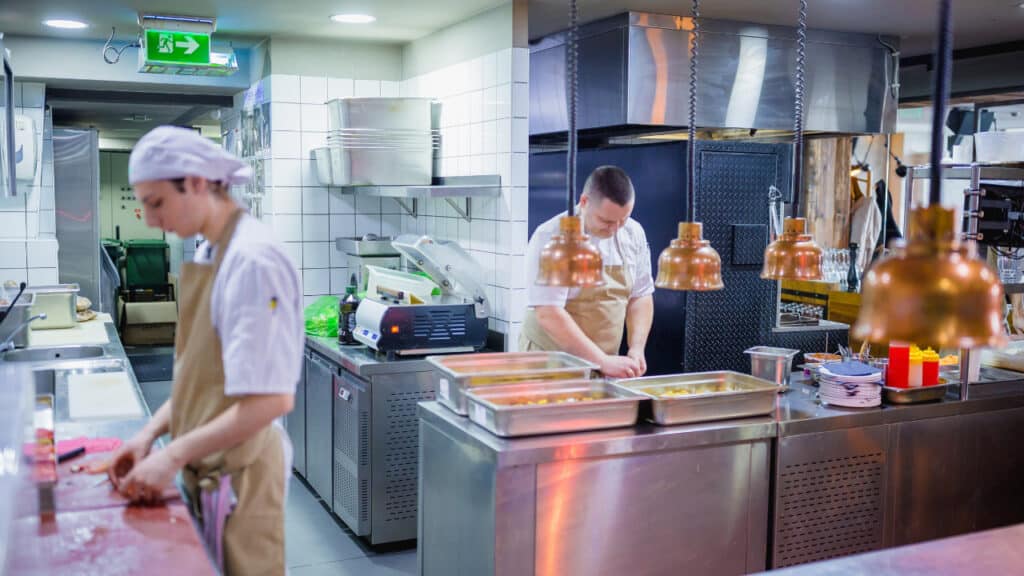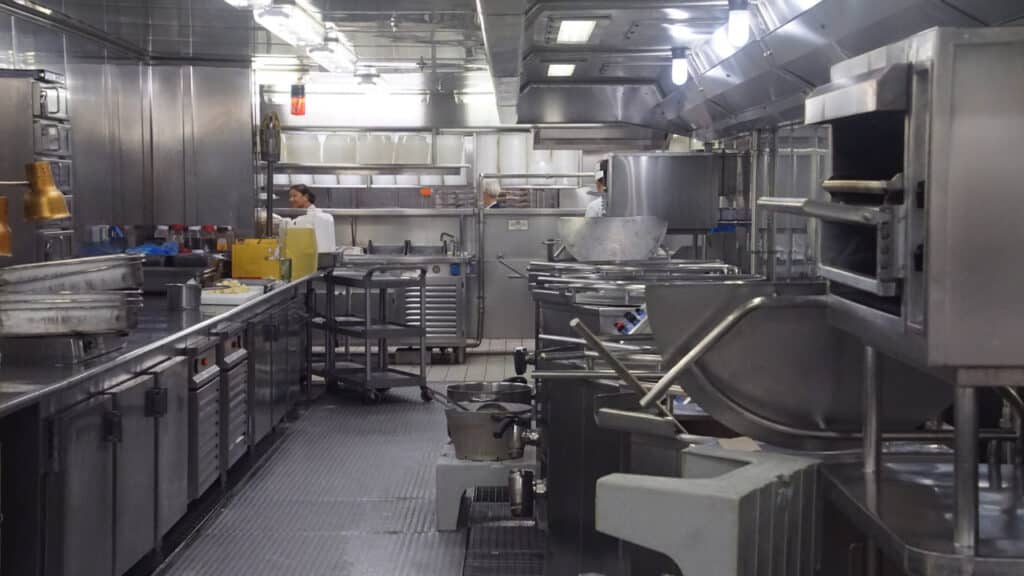Commercial kitchens are the busiest part of any restaurant. The stainless steel countertops, assembling stations, ventilation, kitchen appliances, storage requirements, etc all are super functional on a regular day. Despite being this crucial, the commercial kitchen layout doesn’t get much attention.
No matter if you are building a new restaurant or renovating an older one, the layout of a commercial kitchen is quite important. The commercial kitchen layout in a restaurant explains a lot about its functionality, safety, and workflow. It not only ensures that your kitchen remains fully efficient but also improves the productivity of your staff.
There are different components of a commercial kitchen layout: cleaning section, storage, service area, meal preparation area, etc. The floor plan for a commercial kitchen matters the most.
So if you are an enthusiastic restaurateur looking to expand or renovate the commercial kitchen by improving your restaurant kitchen layout, this blog is for you. Let’s get into the details of the commercial kitchen layout.
Table of Contents
Importance of Commercial Kitchen Layout
Before we talk about different kitchen layout plans, let’s first understand why it is important to work on it. Here are a few reasons why a restaurant’s kitchen layout is important.
Productivity
Are people bumping into each other? Are storages full? Is the washing area maintained properly or not?
All these questions may cross your mind when thinking about commercial kitchen functionality. Well, a commercial kitchen’s layout directly affects the productivity and workflow in the restaurant kitchen. A fully functional kitchen helps to increase productivity. A well-managed kitchen ensures that all the operations in a kitchen are going smoothly.
Safety
Staff safety is another important reason why kitchen layout is important for any restaurant. No matter how big or small a kitchen is, if it’s designed properly and remains organized it also ensures the safety of workers in the kitchen. In fact, safety is one of the components that is kept in mind while designing kitchen layouts to minimize the chances of accidents in the kitchen.
Cost Effective
An effective restaurant kitchen layout will save you tons of money. A dishwashing station properly installed is a long-term asset. Plus, installing adequate and updated appliances is another key factor to remember.
It also reduces the meal preparation time as all the things are quite accessible in the kitchen. So, if you compromise on the layout style just to save a few dollars, you may eventually end up spending a lot more later on.
Health Precautions
The health code is one of the most important factors for a successfully running commercial kitchen. Installing property cold storage units is essential, especially for perishable goods. You have to pass the sanitation and food safety license. But if a washing station is way far from the food preparation area, you may face some difficulty in gaining that license. So yes, the kitchen layout style plays an important factor for the health inspection authorities.
Employee Encouragement
All of the kitchen team spends their entire day manned at each working station. It will result in fast burnout. Strategically the kitchen layout must have ample space according to the kitchen ergonomics to make the long working hours comfortable. Therefore the commercial kitchen layout design must have a positive impact on the employee’s productivity.
5 Best Commercial Kitchen Layout Ideas
Some of the best commercial kitchen layout ideas for small and large kitchens are described below.

1. The Island Design
For a large commercial kitchen, building a kitchen island design is a good approach. The food prepping station is the center of attention in this layout while other stations surround it. Chefs can cook the meals rather more proficiently with a diverse menu. You can cook a variety of dishes at once. Gourmet kitchens are known to have island-design layouts. This layout is preferable for large commercial kitchens.

Advantages
- Allows chefs to collaborate and communicate with one another.
- Makes a visually appealing centerpiece for consumers.
- It also maximized the storage space in a kitchen.
- There is plenty of room for various cooking techniques and equipment.
- Reduces needless motions in the workflow.
Disadvantages
- Takes up a lot of area, making it inappropriate for compact kitchens.
- Additional plumbing and electrical connections may raise construction and equipment expenses.
2. Assembly Line Layout
One of the most common commercial kitchen layouts with a linear shape. It begins with the food prep station, in a straight line, and the part where food is served. In this kitchen type, the central row contains both ingredient and preparation areas in a single line.
The food preparation usually starts at one point and goes through different stages unless it’s complete preparation as it reaches the other end of the assembly line. Mostly found in fast food restaurants, assembly line layout offers much efficiency and focus is the service point.

Advantages
- Suitable for high-volume production and quick servicing.
- It’s suitable for the businesses who don’t have a very versatile menu and there is order repetition for certain dishes.
- Food businesses who work on a model where they assign particular work to each worker.
- It is simple to supervise and control because the process is linear.
Disadvantages
- There isn’t enough room for numerous chefs to work together successfully.
- This kitchen layout can take a toll on an individual’s creativity.
- Assembly line layout is not preferable for all types of commercial kitchen especially for the restaurants with versatile menu.
3. Open Kitchen Layout

Another type of commercial kitchen layout is the open kitchen layout. In this type of layout, customers can see the set of actions in a kitchen. Any commercial kitchen can have an open layout style – all you need is to take down the wall. But for customer safety purposes, a glass partition is usually conjured. This interactive kitchen design is quite unique and can be used for your modern kitchen.
Advantages
- It provides an excellent way to entertain customers while they wait for their meal.
- According to statistics, this results in better productivity in the kitchen as compared to isolated kitchen spaces.
- It is an excellent opportunity to utilize a small space
- Create a customized sitting area by placing bar stools.
Disadvantages
- Loud noises from the kitchen can be distracting for many customers.
- A cooking aura can diminish the entire ambiance of the place.
4. Zone Layout
Just as the name says, this type of commercial kitchen has different zones in the kitchen for specialized functions.
For instance, a specific zone is reversed for food preparation and creation while keeping storage and washing zones separate. There’s a salad station, a frying station, or a pizza station.
In the zone layout, different stations allow creation of multiple foods off the menu without waiting for an order to complete. Hotels commonly have zone layout-style kitchens. Catering services are also known to prefer zone layout kitchen style, especially for large events.

Advantages
- Clear organization and distinct workstations for each task.
- This commercial kitchen layout also allows them to work on multiple dishes simultaneously.
- Zone commercial kitchen layout is suitable for restaurants who have a diverse menu.
- These kitchens usually have an open central space that ensures better movement.
- Allows for a more orderly kitchen operation.
Disadvantages
- This type of layout is not preferable for small commercial kitchens.
- Careful planning is required to guarantee that each zone has enough space and supplies.
- Communication between zones may need to be improved is another challenge for these kitchen layouts.
5. Galley Layout
In this type of layout, all working stations are placed at the perimeters of the kitchen due to the tight space. Two parallel walls are consumed for the kitchen equipment. The galley layout is mostly used in small commercial kitchens with limited sittings.

Advantages
- Multiple cooks can be adjusted despite the small size.
- Best suited for small trucks or cafes for more space.
- In large commercial kitchens, galley layout allow space for free movement of staff.
Disadvantages
- Not suitable for larger kitchens.
- Space might be too cramped for parallel stations.
3 Steps to Create an Effective Commercial Kitchen Layout Plan

1. Consider Menu
Unsurprisingly, a commercial kitchen layout is designed keeping the menu in mind. The kind of food you’re planning to serve is an independent factor. Therefore you will need to speak to the head chef who knows the menu and can help you determine the type of floor plan and layout that is required.
2. Zone Segregation
The standard dining room to kitchen area ratio is 60 to 40. The smaller part of the restaurant is reserved for the kitchen which is further segregated into workstations. When running a small restaurant, you’ll have to make compromises.
The standard zone segregation includes:
- Prep and baking station
- Hot station
- Cold station
- Cleaning station
3. Kitchen Ergonomics
A well-organized kitchen is what a chef needs. Therefore kitchen ergonomics plays a vital role. You can utilize the open shelves and racks instead of closed cabinets. Shelving units are clever and easily mounted on the wall. Plus you can hang the necessary utensils around the workstation without needing to move them throughout the kitchen.
5 Factors to Consider for a Restaurant Kitchen Layout

If you own a small restaurant, careful planning is crucial. Keep in mind the following factors to choose the best kitchen layout.
1. Storage Space
Every commercial kitchen has a dedicated space for storage. Two types of storage spaces are commonly found – cold storage for all the groceries and the other one for cooking utensils and place settings.
For a commercial kitchen dry goods like food items are placed in the commercial fridge (the cold storage). The freezers contain perishable goods. Therefore, you will be needing different forms of storage spaces.
2. Washing Station
Cleaning is a regular chore occurring several times an hour in a commercial kitchen. A separate washing station is a must. The size may vary depending on the daily need. Usually, a separate washing station is installed for food and dishes. This is to prevent any type of contamination and to keep things tidy.
3. Food Preparation
Depending on the type of menu that is served, the food preparation area usually consists of counter space, cutting utensils, and storage containers. It is near the cold storage for a handy workflow. One must allocate appropriate space for this station so that the food ingredients do not come in contact with dirty dishes.
4. Cooking Station
The main action takes place at the cooking station. The area consists of high cooking ranges, commercial fryers, and ovens. These days, cooking stations are usually organized with a digital kitchen order system. A ticket appears on the display of the KDS. This is a highly effective system to streamline all orders without losing the actual ticket.
5. Service
Once the food is prepared, it is time to plate the dishes. That is what the service station is for. This specific point is reserved to keep the food warm and is also closer to the dining area. Meals are properly plated and garnished before servers take the prepared meals to hungry customers. Usually, the service station also consists of heat lamps to keep the food warm until served.
Transform Your Restaurants Right Away
The layout of a commercial kitchen is extremely important no matter what kitchen size you have. But before following any of these kitchen layout ideas be mindful that each one of them has its own pros and cons. So, make sure you find the one that suits your commercial kitchen needs perfectly.
Choose wisely whether you want your customer to visualize the inside of the kitchen or not. Also, cater to the floor plan that will serve maximum space and does not hinder the kitchen staff. It’s best to keep things simple to avoid any further complications in the commercial kitchen layout design. To make an informed decision, we recommend you consult a professional who can guide you accordingly.





